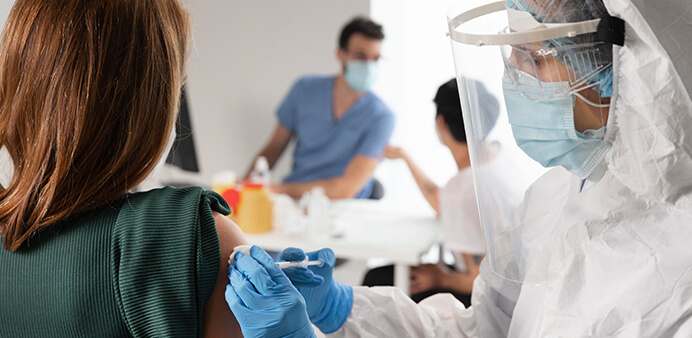
The year 2020 was a year that we will never forget. The COVID-19 infection, first reported in Wuhan, China, is starting to make waves. The pandemic was brutal; the virus was highly infectious and not adequately understood. The death toll was overwhelming.
With poor knowledge about the virus, medical professionals were very quickly overwhelmed. Doctors tried different drug regimens in treating patients, and most failed. It soon became evident that a vaccine was what the world needed, and that’s what the medical and scientific community tried to do.
Medical professionals and scientists went to work immediately. Trying to understand the nature of the virus was quite challenging at first. Later on, they were able to understand it. Armed with the knowledge of how the virus works, scientists and medical personnel went to work trying to produce a vaccine. In 2020, the first trial started. Before long, the vaccines were produced, and then the distribution of the vaccine began.
Breakthrough infections are not supposed to happen in fully vaccinated individuals. However, they occur for a number of reasons that we are going to see shortly.
Vaccines are disease-protective substances, but none ever produced is 100 percent effective. Since the lockdown and travel restrictions have been lifted, this would also contribute to breakthrough infections. In most countries today, there is no longer a compulsory mask mandate.
With people going to crowded places, the chances of a vaccinated person coming into contact with an infected person increases. As the vaccine does not offer 100% protection, there will be a slight probability of coming down with COVID-19.
In addition, healthcare providers may administer the vaccine inappropriately. If this is the case, you may believe you have been vaccinated when, in fact, you have not. Inadequate immunization does not provide protection. This means that your chances of getting infected are still pretty high.
As time progressed, newer variants of the COVID-19 infection appeared. So far, we’ve seen the Delta variant and the Omicron variant. These variants cause more severe symptoms and can spread easily. These new variants have made it more likely for a vaccinated person to come down with the infection. Although it may be possible to still come down with COVID-19 due to the new variants, the vaccines still offer protection.
So even after getting vaccinated, taking a COVID-19 test from time to time will be important. An at-home test kit is the perfect test kit for you.i
Even though vaccinated people can still get COVID, the chances of getting it is reduced compared to the rest of the population. Also, the morbidity from the disease is reduced in vaccinated people. Hence certain persons that are at risk of higher transmission or morbidity should take the vaccine. The following people should take the vaccine:
There would be no memory cells in a person who had never been affected. The body will not be able to fight off the virus without these memory cells. Memory cells are formed when such a person is immunized. Their bodies will be able to fend off the virus thanks to these memory cells. As a result, the odds of infecting such a person are reduced.
The immunization from the disease is not 100 percent effective, so a person may get infected after the infection. Also, the chances of coming into contact with an infected person may increase because of the lifting of the travel restrictions and lockdown orders. The new variants of COVID-19 also play a big role.
Being immunocompromised means that a person has a weak immune system. In the immunocompromised, the body cannot fight off infection as it should. This makes such an individual frequently ill.
If infected with COVID-19, such individuals will have a severe disease manifestation. Severe symptoms of COVID-19, according to the CDC, are difficulty breathing, confusion, chest pain, and loss of speech. When the immunocompromised get vaccinated, they have a better fighting chance.
The vaccine is required for children over 12 who have never been affected. The vaccine is also required for children between the ages of 5 and 11 who are at high risk. According to the UK government, the following is a list of children who are at high risk of developing COVID-19 problems.
It should be noted that children over the age of 12 who have had COVID-19 can still take a single dose if they wish.
As a person advances in age, their immune system begins to weaken. Because of this, their bodies will not be able to fight diseases as they did. Also, the elderly are usually plagued with various illnesses. According to the CDC, such underlying illnesses often cause them to fall ill. It also causes them to have severe symptoms and recover slowly.
The vaccine, once given, acts to boost their immune systems. This protects them from getting infected easily. It also causes them to have milder symptoms and recover more quickly.
Even though taking a vaccine will prevent you from having severe symptoms, getting infected with the disease will still be an unpleasant experience. So how do you prevent that?
A facemask will offer you protection from droplets of an infected person getting into your mouth or nose. You should always wear a facemask whenever you are in a public place, especially in crowded places.
Since reinfection with COVID-19 is an actual possibility, getting tested often will benefit you. The at-home test kit sold by handstations is the perfect at-home test kit. The flowflex rapid antigen test kit or the healgen lateral flow covid-19-antigen testing kit will get the job done quickly.
The at-home test is easy to perform, and results are quickly obtained. The test can be performed if you feel that you have been exposed to the infection. Also, if you begin to get mild symptoms such as fever, headache, sore throat, etc., you should get tested.
Emir Limam – E11 Group B.V. Netherlands – Fraudster
24 May 2023When to Take a Test After Covid Exposure?
30 January 2023A Rapid Antigen Test vs a Lateral Flow Test for Covid-19
30 January 2023